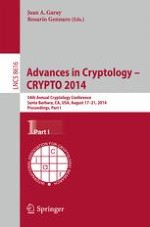The two volume-set, LNCS 8616 and LNCS 8617, constitutes the refereed proceedings of the 34th Annual International Cryptology Conference, CRYPTO 2014, held in Santa Barbara, CA, USA, in August 2014.
The 60 revised full papers presented in LNCS 8616 and LNCS 8617 were carefully reviewed and selected from 227 submissions. The papers are organized in topical sections on symmetric encryption and PRFs; formal methods; hash functions; groups and maps; lattices; asymmetric encryption and signatures; side channels and leakage resilience; obfuscation; FHE; quantum cryptography; foundations of hardness; number-theoretic hardness; information-theoretic security; key exchange and secure communication; zero knowledge; composable security; secure computation - foundations; secure computation - implementations.
